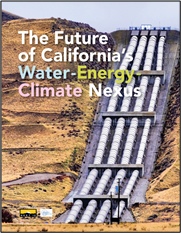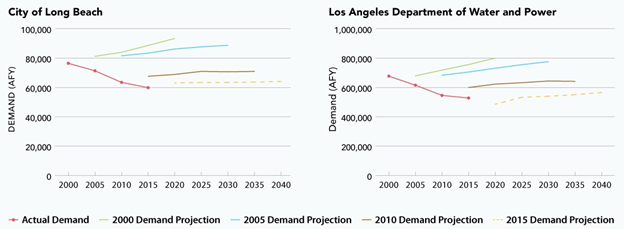Achieving Better Balance In The Water-Energy-Climate Nexus


Trying to balance urban population growth against water scarcity, energy-consumption, and greenhouse gases (GHGs) can feel like being stuck between a rock and a hard place. A recent report — entitled The Future of California’s Water-Energy-Climate Nexus — is a thought-provoking look at the reality of current water-management practices and their energy-consumption impacts. It examines the delicate balance among the many facets of water use and maps out better ways to achieve that balance, offering new perspective on future alternatives for water policymakers and water- and wastewater-treatment professionals, based on science and statistical insights.
While California has had very stark contrasts between the forces of nature and forces of man in terms of drought, water use, and GHG emissions, the concepts introduced in this report form a blueprint for any country/location/community faced with rebalancing corresponding economic and environmental issues.
Multilevel Eye-Opening Insights
Thinking of the water-energy-climate nexus as a big game of rock-paper-scissors — where different layered relationships among common instances affect varying outcomes — makes it easier to appreciate the interrelatedness of energy and climate-related impacts from various types of water treatment and use. The report documents many of those energy and climate-impact relationships based on various types of water use — including urban water use, agricultural water use, as well as water transmission efforts (Figure 1). It addresses the net impacts of various tradeoff scenarios. It also includes case studies of successful changes experienced through energy recovery from wastewater treatment; sustainable groundwater activities; and greater local water-resource generation through stormwater capture, indirect potable reuse, and direct potable reuse.

Graphic courtesy of Next 10
Figure 1. While this 68-page report — commissioned by Next 10 and produced by the Pacific Institute — was written specifically around experiences and issues related to the State of California’s water challenges, its insights offer value for any community facing similar concerns. It examines greenhouse-gas-emission and cost implications for various types of water use and provides case studies of successful adaptations in water-management practices.
Challenging Circumstances
According to the report, about 20 percent of the state’s electricity use, 33 percent of its natural gas consumption, and 88-billion gallons of diesel fuel are consumed by water operations and water heating. Indoor residential water use is the most energy-intensive type of water use. Positive notes show that from 2000 through 2015, per-capita water demand from the state’s 10 largest urban water suppliers dropped by an average of 25 percent (Figure 2). Also, efforts to decarbonize electricity generation with solar, wind, and hydroelectric power look to be positive contributors moving forward.
Several interesting perspectives that stand out in the report include just how much of an impact different types of water use have on overall energy consumption and greenhouse gases. Environmental impacts include not only the volume of water being consumed, but the relative energy consumption and GHG emissions associated with each type of water use. With the pumping energy required for long-distance water transmission being such a big factor, local water-reuse efforts can play an important role (if energy requirements are not too high).
The report specifically notes that, “Urban water-efficiency improvements can have the largest statewide effect on California’s water-related energy use and GHG emissions because urban water is much more energy-intensive than agricultural water.” (Urban water can require up to 9X the energy across all relevant aspects of use — from source-water pumping to treatment to water heaters to wastewater treatment.) Also, “Water-related GHG emissions are driven by the pace of California’s electricity decarbonization and end-use electrification.”
Based on all the above factors, the report compares the potential energy and GHG impacts at low, mid-range, and high water-consumption rates across both urban and agricultural uses (Figure 3). The low-demand scenario assumed a continued 2-percent annual decline in per-capita demand in the face of population growth. The mid-range scenario assumed a constant per-capita demand. The high-demand scenario incorporated the highest future demand based on water-supplier projections.

Graphic courtesy of Next 10
Figure 2. Urban water use among California’s 10 largest water suppliers actually declined as compared to water-supplier forecasts between 2000 and 2015, as shown by these representative examples from the City of Long Beach and the Los Angeles Department of Water and Power. Such differences were incorporated in the low-, mid-, and high-range water-consumption estimates used to project future energy consumption related to water use.

Graphic courtesy of Next 10
Figure 3. The report projects water-demand and energy-consumption expectations for different aspect of the water cycle, based on high- (left), mid- (center), and low-demand (right) scenarios. This chart projects significant differences in impacts of water-related energy consumption for various aspects of water operations between 2015 and 2035, based on those three scenarios.
Recommendations
Based on the fact-finding and analyses included in the report, the authors communicated six specific policy recommendations:
- “Expand urban water conservation and efficiency efforts.” (Agricultural water use shows relatively little difference in electricity use and GHG reductions across high-, mid-, and low-use scenarios.)
- “Accelerate water heater electrification.” (Gas water heaters are the most energy- and GHG-intensive aspect of the most energy- and GHG-intensive urban-water-use category.)
- “Maintain groundwater levels and expand more flexible, high-efficiency groundwater pumps.” (Keeping groundwater levels higher through conservation and aquifer regeneration will reduce pumping energy needs.)
- “Provide financial incentives and regulatory pathways for water suppliers to invest in less energy- and greenhouse gas-intensive water systems, including through existing financial incentives and programs for energy efficiency and greenhouse gas reduction.” (For example, supporting conversions of gas water heaters to electric water heaters would have a significant impact.)
- “Expand and standardize water data reporting and energy usage tracking.” (The data-gathering phase of the report revealed gaps in the availability and/or communication of data that could guide water systems toward lower water-energy-climate impacts.)
- “Formalize coordination between water and energy regulatory agencies about forecasted energy demand changes.” (Capturing the attention and support of policymakers can go a long way toward generating beneficial outcomes at the practical-action level.)
Next Steps
Interested parties — ranging from environmentally sensitive government policymakers down to financially sensitive treatment-plant management — can learn more about available opportunities for improvement by requesting a copy of the 68-page report or viewing the recorded webinar on its creation and findings. That webinar introduces the premise behind the report, documents the science behind its findings, and provides real-world perspective from a panel of professionals involved in the creation of the report.
About Next 10 and Pacific Institute
Next 10 is a non-profit and non-partisan organization focused on the environment, economy, and quality-of-life issues in the State of California. But their work on the water-energy-climate nexus offers valuable insights to communities struggling with similar issues worldwide. The Pacific Institute is a global, water think tank focused on creating and advancing solutions to pressing water challenges. An important part of their focus includes the relationship between climate and water.
